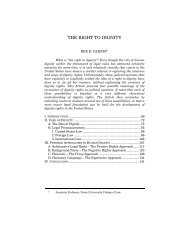A Right to Media? Lorie M. Graham - Columbia Law School
A Right to Media? Lorie M. Graham - Columbia Law School
A Right to Media? Lorie M. Graham - Columbia Law School
Create successful ePaper yourself
Turn your PDF publications into a flip-book with our unique Google optimized e-Paper software.
472 COLUMBIA HUMAN RIGHTS LAW REVIEW [41:429<br />
without discrimination or, more precisely, that there be no<br />
individuals or groups that are excluded from access <strong>to</strong> such media.” 158<br />
One final regional example is the League of Arab States’<br />
Revised Arab Charter on Human <strong>Right</strong>s, which recognizes the<br />
freedom of expression and its connection <strong>to</strong> culture and language.<br />
Article 3 of the Charter states that State Parties will ensure that<br />
individuals will be able <strong>to</strong> enjoy the rights and freedoms within the<br />
Charter without “distinction on the grounds of race, colour, sex,<br />
language, religious belief, opinion, thought, national or social origin,<br />
wealth, birth or physical or mental disability.” 159 Article 25 states<br />
that groups shall not be denied the “right <strong>to</strong> enjoy their own culture,<br />
<strong>to</strong> use their own language and <strong>to</strong> practice their own religion.” 160 In<br />
Article 32, the Charter guarantees the right <strong>to</strong> “information and <strong>to</strong><br />
freedom of opinion and expression, as well as the right <strong>to</strong> seek,<br />
receive and impart information and ideas through any medium,<br />
regardless of geographical boundaries.” 161<br />
Most of the regional instruments discussed above do not<br />
articulate a per se right <strong>to</strong> media. They do, however, <strong>to</strong>uch upon<br />
many facets of media that promote diversity of ideas and opinions.<br />
These facets include freedom of expression and dissemination of<br />
ideas through media, the right <strong>to</strong> seek and receive information<br />
through media, the right of access <strong>to</strong> media without discrimination,<br />
and the right <strong>to</strong> open, independent, and au<strong>to</strong>nomous media. As<br />
detailed below, these regional norms, along with international law,<br />
are helping <strong>to</strong> shape domestic law and practice with respect <strong>to</strong><br />
indigenous peoples’ access <strong>to</strong>, and development of, media.<br />
C. Domestic Practices: Case Studies<br />
“Indigenous media” is a general term used <strong>to</strong> refer <strong>to</strong> the<br />
wide range of media made by indigenous peoples or targeted at the<br />
indigenous community, “often with the goal of offering alternative<br />
media representations, identity positions and participation<br />
practices.” 162 Thus, the aim of indigenous media is <strong>to</strong> educate,<br />
empower, and reinvigorate indigenous communities through<br />
158. Compulsory Membership, supra note 24, para. 34.<br />
159. League of Arab States, Revised Arab Charter on Human <strong>Right</strong>s art. 3,<br />
para. 1, adopted May 22, 2004 (entered in<strong>to</strong> force Mar. 15, 2008).<br />
160. Id. art. 25.<br />
161. Id. art. 32, para. 1.<br />
162. Sari Pietikäinen, Broadcasting Indigenous Voices: Sami Minority<br />
<strong>Media</strong> Production, 23 Eur. J. Comm. 173, 174 (2008).















